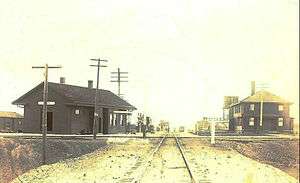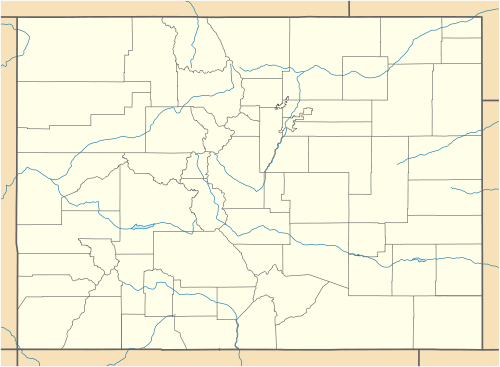Limon Railroad Depot
Limon | |||||||||||||||||
|---|---|---|---|---|---|---|---|---|---|---|---|---|---|---|---|---|---|
| Former Rock Island Line and Union Pacific station[1][2] | |||||||||||||||||
 The Depot in 1909. | |||||||||||||||||
| Location |
897 First Street Limon, Colorado[3] | ||||||||||||||||
| Coordinates | 39°15′37″N 103°41′14″W / 39.26028°N 103.68722°W | ||||||||||||||||
| Owned by | Limon Historical Society[2][4] | ||||||||||||||||
| Tracks | 1 | ||||||||||||||||
| Construction | |||||||||||||||||
| Structure type | at-grade | ||||||||||||||||
| History | |||||||||||||||||
| Opened | 1889[4] | ||||||||||||||||
| Rebuilt | 1904, 1910[5] | ||||||||||||||||
| Services | |||||||||||||||||
| |||||||||||||||||
|
Limon Railroad Depot | |||||||||||||||||
  | |||||||||||||||||
| Location | 897 First St., Limon, Colorado | ||||||||||||||||
| Coordinates | 39°15′37″N 103°41′14″W / 39.26028°N 103.68722°WCoordinates: 39°15′37″N 103°41′14″W / 39.26028°N 103.68722°W | ||||||||||||||||
| Area | Less than 1 acre (0.4 ha) | ||||||||||||||||
| Architect | Chicago, Rock Island & Pacific RR | ||||||||||||||||
| Architectural style | Late 19th And Early 20th Century American Movements | ||||||||||||||||
| MPS | Railroads in Colorado, 1858-1948 MPS | ||||||||||||||||
| NRHP Reference # | 03000038[6] | ||||||||||||||||
| Added to NRHP | February 20, 2003 | ||||||||||||||||
Limon Railroad Depot (also known as Limon Station) was a major Union Pacific and Chicago, Rock Island and Pacific Railroad station in Limon, Colorado. It has been on the National Register of Historical Places since 2003. The now museum is one of seven still standing Rock Island Line stations in Colorado, and the only one restored.[7]
History
In 1870, the Kansas Pacific railroad, now Union Pacific, was the first railroad to pass where the town of Limon is today.[5][8] The town was not incorporated (and didn't have a station) yet so trains passed by without stopping on their way to Denver.
In 1888, the Rock Island Line constructed a camp for workers building the main line to Colorado Springs.[9] The track intersected the Union Pacific track where the depot is now.[8][10] The town was named after the construction supervisor for the railroad, John Limon.[9][11][12] The Chicago, Rock Island and Pacific (Rock Island Line) then decided that Denver would be a better western terminus for their trains. In 1889, the two railroads reached an agreement to allow "The Rock" to use Union Pacific's Limon Subdivision line on trackage rights.[10][13][14][15] Before that, trains went to Colorado Springs and used Denver and Rio Grande Western Railroad track north to Denver.[16] Limon became a major junction for the two railroads,[9] since it was where trains such as the Rocky Mountain Rocket split to Denver or Colorado Springs, respectively.[5][17]
In the 1980s, approximately 70 miles of former Rock Island and Cadillac and Lake City Railway track between Limon and Colorado Springs was removed.[8] Evidence of the former right-of-way can still be easily seen along the route.[18] In Colorado Springs, a 5.8 mile part of the right-of-way has been turned into a rail trail known as the Rock Island Trail.[19][20] Northeast of Colorado Springs, the track closely followed U.S. Highway 24 and included a large trestle over Big Sandy Creek.
The building was damaged by the 1990 tornado that tore through Limon, destroying 50 to 75 percent of the business district.[21] The first major event after the tornado was the Weekend Western Festival in June, 1992.[1]
Service
Passenger
Limon was considered a union depot for the Union Pacific and Rock Island Line railways.[1][4] It served many trains on the ex-Kansas Pacific Kansas City—Denver main line and Rock Island Line Omaha—Colorado Springs main line. It was the end of the "Limon Shuffle" where the popular Rocky Mountain Rocket train split into two trains.[22][23]
Freight
Limon is at the western end of the Kyle Railroad, a short line railroad that operates on the former Rock Island Line to Nebraska.[8][24] The railroad entered service in 1982.[25] The line often interchanges cars with the Union Pacific. Union Pacific also runs about 12 trains a day on the Limon Subdivision, the ex-Kansas Pacific main line.[24]
Limon Heritage Museum and Railroad Park
The depot is now home to the Limon Heritage Museum and Railroad Park, a large historical museum. Railroad Park includes a Union Pacific caboose, a model railroad layout of the 1940s Limon Yard, and a 1914 dining car.[4][5] It is the site of the annual Limon Railroad Days, which happens in June.[24][26]
References
- 1 2 3 Patrick O'Driscoll (June 4, 1992). "Evening excursions halted, but depot events seek to lure visitors". Denver Post. p. 3B.
- 1 2 ourjourney.info. Retrieved February 18, 2011
- ↑ Weekly listing on properties taken action on. Retrieved February 16, 2011
- 1 2 3 4 Town of Limon.com. Retrieved February 16, 2011
- 1 2 3 4 Lincoln County Things to see. Retrieved February 18, 2011
- ↑ National Park Service (2009-03-13). "National Register Information System". National Register of Historic Places. National Park Service.
- ↑ Listings in Lincoln County. Colorado Historical Society. Retrieved March 7, 2011
- 1 2 3 4 Lincoln County History. Retrieved February 20, 2011
- 1 2 3 Wiatrowski, Claude (2009). "The Southeast". Historic Colorado: Day Trips & Weekend Getaways to Historic Towns, Cities, Sites and Wonders. MBI Publishing Company. p. 197. ISBN 978-0-7603-3256-6.
- 1 2 Schafer, Mike (2003). Classic American Railroads, Volume III. Saint Paul, MN: MBI. p. 75. ISBN 076031649X. OCLC 768623553.
- ↑ colorado.com. Retrieved February 20, 2011
- ↑ Town of the week. Retrieved February 20, 2011
- ↑ Brief History of the Rock Island Line. Retrieved February 20, 2011
- ↑ "THE ROCK - THIRTY YEARS GONE". DRGW.net. March 31, 2010. Retrieved February 20, 2011.
- ↑ History of the Rock Island Line. Retrieved February 20, 2011
- ↑ Traffic Service Corporation (July 3, 1915). "Traffic world, Volume 16". XVI (460): 460.
- ↑ Rock Island Line map. Retrieved February 20, 2011
- ↑ Google (February 21, 2011). "Rock Island Right-of-way" (Map). Google Maps. Google. Retrieved February 21, 2011.
- ↑ Rock Island Trail. Retrieved February 20, 2011
- ↑ Map of Rock Island Trail. (PDF) Retrieved February 20, 2011
- ↑ Associated Press (June 7, 1990). "Tornado Rips Through Colorado Farm Town". Mount Airy News.
- ↑ Rocky Mountain Rocket timetable. Retrieved February 20, 2011
- ↑ Wiatrowski, Claude (2007). "Rock Island". Railroads Across North America. MBI Publishing Company. p. 28. ISBN 978-0-7603-2976-4.
- 1 2 3 Limon Train Show. Retrieved February 20, 2011
- ↑ Associated Press (August 27, 1986). "Runaway cars roll 31 miles, kill two men". Fort Scott Tribune.
- ↑ "Limon celebrating Railroad Days June 12–13". Fort Morgan Times. May 13, 2010. Retrieved February 26, 2011.
External links
- Limon Heritage Museum and Railroad Park - official site
- Picture of station
- An Union Pacific train crossing the C & RI at Limon; ca. 1976
- ourjourney.info
